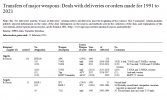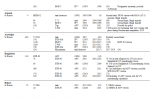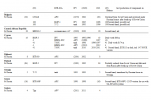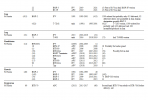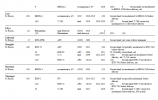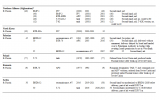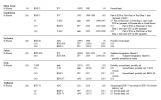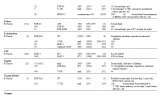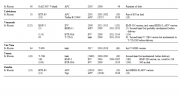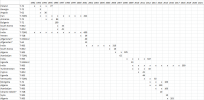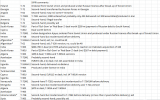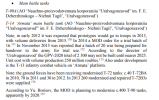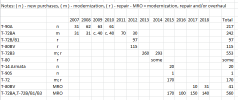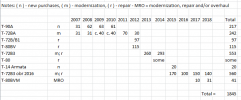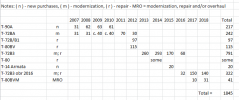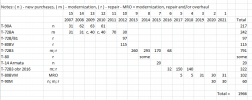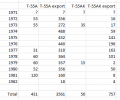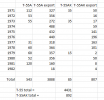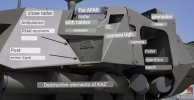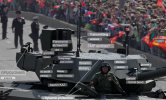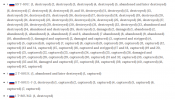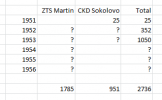Antares
Respected Leader
Bmpd-blogilla on ollut tapana julkistaa oma listansa Venäjän viennistä per vuosi, laitan tähän alle spoilerin taakse nämä artikkelit aikaväliltä 2010-2021: LÄHDE
Artikkelit löytyvät kätevästi, kun hakee heidän blogista hakusanalla Регистра ООН eli UN Register. Näissä viitataan siis jokavuotiseen Venäjän raporttiin, joka toimitetaan YK:lle (UN Register of Conventional Arms - lyhennetään usein muotoon UNROCA). KOSKA Venäjän raportti on ollut aina puutteellinen toimitettujen tietojen osalta (erityisesti vuoden 2016 jälkeen), bmpd-blogilla on ollut tapana julkaista omat "muistiinpanonsa" vuoden aikana kuulluista vientitoimituksista (ainakin niissä tapauksissa joissa heillä on kommentoitavaa).
He ovat myös seuranneet Ukrainan vientitoimituksia, ne löytyvät jakamani linkin takaa JA tuolla hakusanalla löytyy muitakin artikkeleita esim. yksi Valko-Venäjää koskeva.
HUOM: tämä on hyvin epätäydellinen lista, UNROCA:n julkaisemat tiedot ovat ilmoittajan hyväntahtoisuuden varassa. Täten Venäjän osalta ne ovat hyvin puutteelliset. Bmpd-blogin tekemien lisäysten / muistiinpanojen jälkeenkin alle lainaamani on vain osaksi hyödyllinen, koska he eivät välttämättä kuule kaikkia tapauksia eivätkä tohdi välttämättä julkaista kaikkea kuulemaansa (varsinkin vuoden 2016 jälkeen), mutta paras silti ottaa tänne talteen. Varsinkin vuoden 2016 jälkeen nämä raportit muuttuivat hyvin ohuiksi ja puutteellisiksi.
Jos näitä tutkii tarkemmin, voi olla hyvä klikata alkuperäisen artikkelin linkkiä (jaettu spoilerin takana, linkki ennen otsikkoa) ja käydä lukemassa kommentit artikkelin alta. En mene takuuseen mutta joskus siellä voi olla hyviä tiedonjyväsiä, jos jotain on jäänyt kirjoittamatta tai artikkelissa on virheitä. Toki samalla tulee altistaneensa itsensä venäläiselle kommentointikulttuurille, mikä on usein rujo - tämä varoitukseksi, kaiken varalta.
Jaoin jo aikaisemmin tässä ketjussa näistä raporteista koostamani taulukon, se löytyy tästä viestistä (sisältää pelkästään panssarivaunut): LINKKI

Tässä tiedot aikaväliltä 2010-2015, katso seuraava viesti missä on tiedot aikaväliltä 2016-2021:
Artikkelit löytyvät kätevästi, kun hakee heidän blogista hakusanalla Регистра ООН eli UN Register. Näissä viitataan siis jokavuotiseen Venäjän raporttiin, joka toimitetaan YK:lle (UN Register of Conventional Arms - lyhennetään usein muotoon UNROCA). KOSKA Venäjän raportti on ollut aina puutteellinen toimitettujen tietojen osalta (erityisesti vuoden 2016 jälkeen), bmpd-blogilla on ollut tapana julkaista omat "muistiinpanonsa" vuoden aikana kuulluista vientitoimituksista (ainakin niissä tapauksissa joissa heillä on kommentoitavaa).
He ovat myös seuranneet Ukrainan vientitoimituksia, ne löytyvät jakamani linkin takaa JA tuolla hakusanalla löytyy muitakin artikkeleita esim. yksi Valko-Venäjää koskeva.
HUOM: tämä on hyvin epätäydellinen lista, UNROCA:n julkaisemat tiedot ovat ilmoittajan hyväntahtoisuuden varassa. Täten Venäjän osalta ne ovat hyvin puutteelliset. Bmpd-blogin tekemien lisäysten / muistiinpanojen jälkeenkin alle lainaamani on vain osaksi hyödyllinen, koska he eivät välttämättä kuule kaikkia tapauksia eivätkä tohdi välttämättä julkaista kaikkea kuulemaansa (varsinkin vuoden 2016 jälkeen), mutta paras silti ottaa tänne talteen. Varsinkin vuoden 2016 jälkeen nämä raportit muuttuivat hyvin ohuiksi ja puutteellisiksi.
Jos näitä tutkii tarkemmin, voi olla hyvä klikata alkuperäisen artikkelin linkkiä (jaettu spoilerin takana, linkki ennen otsikkoa) ja käydä lukemassa kommentit artikkelin alta. En mene takuuseen mutta joskus siellä voi olla hyviä tiedonjyväsiä, jos jotain on jäänyt kirjoittamatta tai artikkelissa on virheitä. Toki samalla tulee altistaneensa itsensä venäläiselle kommentointikulttuurille, mikä on usein rujo - tämä varoitukseksi, kaiken varalta.
Jaoin jo aikaisemmin tässä ketjussa näistä raporteista koostamani taulukon, se löytyy tästä viestistä (sisältää pelkästään panssarivaunut): LINKKI
Tässä tiedot aikaväliltä 2010-2015, katso seuraava viesti missä on tiedot aikaväliltä 2016-2021:
https://bmpd.livejournal.com/37231.html
Russia's 2010 Report to the UN Register of Conventional Arms
bmpd
July 19th, 2011
As usual, the report of the Russian Federation for 2010 to the UN Register of Conventional Arms is relatively sparse in detail - in particular, the types of equipment exported are traditionally not indicated. However, in general, most of the data provided in the Russian report corresponds to information about Russian arms exports published in the media. Despite the absence of indications in the report of types of weapons, the bulk of the transfers are easily identified. We can say that Russia's report for 2010 does not contain any special sensations and no fundamentally new information.
The information on arms transfers declared by Russia in the report for 2010 to the UN Register can be distributed by country as follows (identification of systems and notes are ours)
India - 20 T-90S / SK tanks (the last of 124 ready under the contract in 2007, the supply of assembly kits, as usual, is not indicated), 112 guided missiles (according to the Indian report - 110 missiles: 80 air-to-air - apparently, as usual, RVV-AE and R-73E - and 30 anti-ship - apparently, also, as usual, 3M24E and 3M54E)
Cyprus - 27 T-80U / UK tanks (the first of 41 contracted out of stock in 2009)
Bangladesh - 40 AFVs (apparently, another BTR-80 with UN money)
Indonesia - 17 AFVs (BMP-3F), 3 combat aircraft (Su-27SKM), 3 combat helicopters (newly built Mi-35P), 4 guided missiles ("Yakhont" )
Yemen - 94 AFVs (BTR-80A)
Kuwait - 25 AFVs (BMP-3 optional)
Sudan - 45 AFVs (presumably the next BTR-80A)
Libya - 4 armored fighting vehicles (no data, but possibly BMP-3. Perhaps only a transfer for testing)
Turkmenistan - 8 artillery systems (it is not clear what it is about)
Vietnam - 2 combat aircraft (possibly Su-30MK2 of some tranche), 32 missiles ("Yakhonty" to the delivered division "Bastion-P")
Brazil - 6 combat helicopters (Mi-35M of new construction - in fact, only 3), 48 launchers and 62 missiles MANPADS "Igla-S" Venezuela
- 4 helicopters (Mi-17)
China - 7 helicopters (Mi-17)
Myanmar - 4 helicopters (Mi-35P from stock with repairs)
Ethiopia - 8 helicopters (presumably Mi-24 from stock)
Syria - 81 guided missiles (part - " Yakhonts" to the delivered "Bastions-P", part - most likely, air-to-air missiles")
Algeria - 139 guided missiles (apparently, mostly ammunition for the delivered Su-30MKI (A), plus, possibly, anti-ship 3M24E and 3M54E).
Egypt - 440 MANPADS missiles (apparently, Igla-S, mainly in Streltsy for the modernization of ZSU-23-4).
As usual, the Russian report lacks information about a number of known shipments - for example, 6 T-90S tanks and a certain number of BMP-3s to Turkmenistan. Information about military Mi-17 deliveries is also clearly incomplete. There are no transfers to Mongolia at all, and, apparently, to Armenia, Azerbaijan, Kazakhstan and Belarus.
-
https://bmpd.livejournal.com/36921.html
Report of Belarus for 2010 to the UN Register of Conventional Arms: Clarification with the Yemeni T-80B
bmpd
July 19th, 2011
The most curious part of Belarus' report for 2010 to the UN Register of Conventional Arms is the appearance in the report of information about the delivery of 66 main T-80B tanks by Belarus to Yemen.
Let us recall that information about the purchase by Yemen of a large batch of T-80B tanks from the presence of the armed forces of Russia or Belarus has been circulating since 2009. This delivery was indirectly confirmed in May 2011, when the State Enterprise "Kharkov Armored Repair Plant" announced that by June it would complete a two-year contract for the overhaul of about 150 tank gas turbine engines, as well as guided weapon systems and sights, concluded "with the country of the Middle East" .
The Belarusian report finally clarifies this situation, declaring the delivery of 66 T-80B tanks to Yemen in 2010. It is still unclear how many T-80B tanks Yemen will eventually receive (apparently, deliveries were continued in 2011), as well as whether these tanks were taken from storage in Belarus, or completely or at least partially re-exported from Russia. Recall that after the collapse of the USSR, Belarus received 92 T-80B tanks from the 11th Guards Tank Division of the GVSG, which was withdrawn to the territory of the republic in 1992. Since the mid-nineties, these 92 T-80B tanks have been in storage in Belarus, offered for sale abroad.
The sale of the T-80B to Yemen was the first delivery of tanks of this modification in "commodity" quantities outside the former USSR.
In addition to the indicated delivery of 66 T-80B tanks to Yemen, Belarus, in its report for 2010 to the UN Register, announced the following transfers of weapons (by country): Azerbaijan -
1 Su-25 attack aircraft, 30 D-30 howitzers
Sudan - 1 Su- 25
Nigeria - 2 Mi-24 attack helicopters
Uganda - 1 Mi-24 attack helicopter
-
https://bmpd.livejournal.com/479236.html
Russia's report to the UN Register of Conventional Arms for 2011
bmpd
March 14th, 2013
The website of the UN Register of Conventional Arms (www.un.org/disarmament/convarms/Register) published the annual report of the Russian Federation to the Register for 2011 with a huge delay. Although the report was submitted by the Russian side to the Register on May 31, 2012, however, it was posted on the Register website in a "package" of reports from another 11 countries, prepared only on January 30, 2013 (document A/67/212/Add.2 ).
According to the report, the Russian Federation exported in 2011 (types of equipment, as usual, are not indicated in the report, and are added by us in brackets):
Tanks :
Venezuela - 35 (T-72B1V)
Cyprus - 14 (T-80UK)
Uganda - 44 (T-90CA)
Armored vehicles:
Bangladesh - 80 (BTR-80A)
Venezuela - 47 (15 BMP-3 and 32 BTR-80A )
Kazakhstan - 11 (3 BMPT and 8 BTR-80A)
Kuwait - 45 (BMP-3)
Uganda - 32 (BTR-80?)
Artillery systems:
Venezuela - 65 (17 2S23, 24 2S12, 24 BM-21)
Kazakhstan - 3 (TOS-1)
Combat aircraft:
Algeria - 26 (16 Yak-130, 8 Su-30MKI(A), 2 - Su-24M ? )
Vietnam - 8 (Su-30MK2)
Jordan - 2 (Il-76MF-EI )
Myanmar - 14 (MiG-29)
Uganda - 4 (Su-30MK2)
Combat helicopters:
Azerbaijan - 4 (Mi-35M)
India - 15 (Mi-17V-5)
Indonesia - 6 (Mi-17V-5)
China - 5 (Ka-31)
Myanmar - 4 (Mi-24P)
Peru - 8 (2 Mi-35P, 6 Mi-17V-5)
Sudan - 12 (probably 10 Mi -24P for Sudan and 2 Mi-17V-5 for South Sudan)
USA - 9 (Mi-17V-5, for Afghanistan)
Thailand - 3 (Mi-17V-5)
Warships:
Vietnam - 3 (2 patrol ships of project 11661E and 1 project 10412 patrol boat)
Turkmenistan - 2 (project 12418 missile boats)
Guided missiles:
Algeria - 68
Bangladesh - 36
Vietnam - 96
India - 270
Myanmar - 40
Uganda - 30
Syria - 74
Man-portable air defense systems:
Azerbaijan - 100 launchers and 500 missiles
Brazil - 8 launchers and 18 missiles
Venezuela - 300 launchers and 1,500 missiles
Egypt - 192 launchers and 647 missiles
Sudan - 25 launchers and 25 missiles
Thailand - 5 launchers and 30 missiles
Turkmenistan - 8 launchers and 24 missiles
-
https://bmpd.livejournal.com/545949.html
Report of Russia to the UN Register for 2012
bmpd
June 20th, 2013
Data from the official report of the Russian Federation to the Register for 2012 appeared on the website of the UN Register of Conventional Arms .
According to this information, Russia officially declared the delivery in 2012 for the export of the following weapons that fall under the UN Register. As usual, the types of equipment are not indicated in the Russian report, so the corresponding notes were made by us.
I. Main tanks:
Algeria - 86 (T-90CA)
Venezuela - 42 (T-72B1V)
II. Armored combat vehicles:
Algeria - 5 (BREM-1CA)
Bangladesh - 70 (BTR-80A)
Venezuela - 124 (BMP-3, BTR-80A, special vehicles)
Kazakhstan - 73 (BTR-82A)
Cyprus - 4 (apparently, BREM- 80Y)
III. Large-caliber artillery systems:
Venezuela - 76 (2S19M, 2S23, 2S12, MLRS BM-21 and Smerch)
Azerbaijan - 18 (2S19M)
IV. Combat aircraft:
Algeria - 6 (Su-30MKI(A))
Vietnam - 10 (Su-30MK2)
India - 5 (1 Su-30MKI and 4 MiG-29K/KUB, vehicle kits for the Su-30MKI are not included)
Myanmar - 3 ( 2 MiG-29 and 1 MiG-29UB)
Uganda - 2 Su-30MK2
V. Combat helicopters:
Sudan - 4 (Mi-24P)
USA - 12 (Mi-17V-5, for Afghanistan)
Egypt - 10 (Mi-17V-5)
Mexico - 3 (Mi-17)
India - 31 (Mi-17V-5)
Azerbaijan - 8 (Mi-35M)
Bangladesh - 3 (Mi-17)
Brazil - 3 (Mi-35M)
VI. Warships:
India - 2 (project 11356 frigates)
Vietnam - 2 (apparently, patrol boats of project 10412)
VII (a). Missiles and rocket launchers:
Vietnam - 40 (apparently, aviation and anti-ship missiles 3M24E)
India - 37 (apparently, aviation and Club)
Turkmenistan - 32 (apparently, anti-ship missiles 3M24E)
VII (b). Portable SAMs:
Venezuela - 400 launchers and 2,000 missiles
Brazil - 8 launchers and 18 missiles
Azerbaijan - 200 launchers and 1,000 missiles
-
https://bmpd.livejournal.com/885556.html
Russia's report to the UN Register of Conventional Arms for 2013
bmpd
June 12th, 2014
Data from the official report of the Russian Federation to the Register for 2013 appeared on the website of the UN Register of Conventional Arms .
According to this information, Russia officially declared the delivery in 2013 for export of the following weapons that fall under the UN Register. As usual, the types of equipment are not indicated in the Russian report, so the corresponding notes were made by us.
I. Main tanks:
Azerbaijan - 10 (T-90S)
Algeria - 101 (T-90CA)
Armenia - 35 (T-72B ?)
Venezuela - 15 (T-72B1V)
II. Armored fighting vehicles:
Azerbaijan - 10 (BMP-3)
Algeria - 10 (BREM-1CA?)
Armenia - 110 (BMP-2 and/or BTR-80?)
Bangladesh - 73 (BTR-80A)
Venezuela - 36 (BMP- 3, BTR-80A, special vehicles)
Indonesia - 37 (BMP-3F)
Libya - 7 (SPTRK "Chrizantema-S")
III. Large-caliber artillery systems:
Azerbaijan - 438 (!! - 2S19M, 2S31, MLRS "Smerch", TOS-1A and what else?)
IV. Combat aircraft:
India - 7 (MiG-29K / KUB, vehicle kits for the Su-30MKI are not taken into account)
Indonesia - 6 (Su-30MK2)
Myanmar - 2 (MiG-29UB)
V. Combat helicopters:
Azerbaijan - 25 (8 Mi-35M and 17 Mi-17V-1)
Ghana - 4 (Mi-171Sh)
India - 43 (Mi-17V-5)
Iraq - 4 (Mi-35M)
Kazakhstan - 4 (Mi-17)
VI. Warships:
Vietnam - 1 (project 06361 submarine)
India - 1 (project 11356 frigate)
For missiles in the published report form, as you can understand, there is confusion over categories a) and b). Apparently, it should look like this:
VII (a). Missiles and rocket launchers:
Algeria - 4 (?)
Vietnam - 13 (apparently aviation and anti-ship missiles 3M24E)
India - 361 (apparently aviation and Club)
Indonesia - 52 (apparently aviation)
Malaysia - 20 (RVV-AE)
Turkmenistan - 8 (apparently, anti-ship missiles 3M24E)
VII (b). Portable air defense systems:
Armenia - 50 launchers and 200 missiles
Egypt - 120 launchers and 468 missiles
Oman - 24 launchers and 102 missiles
Turkmenistan - 15 launchers and 60 missiles
-
https://bmpd.livejournal.com/1541647.html
Russia's report to the UN Register of Conventional Arms for 2014
bmpd
October 24th, 2015
On the website of the UN Register of Conventional Arms, data from the official report of the Russian Federation to the Register for 2014 appeared with a significant delay.
According to the information given there, Russia officially declared the delivery in 2014 for the export of the following weapons that fall under the UN Register. As usual, the types of weapons and equipment are not indicated in the Russian report, so we made the corresponding notes.
It is easy to see that the report suffers from obvious incompleteness and a significant part of the deliveries was not included in it (the same combat helicopters for Iraq).

Azerbaijani President Ilham Aliyev inspects the T-90S tank received by Azerbaijan from Russia. Nakhichevan, 04/08/2014 (c) Press Service of the President of Azerbaijan
I. Main tanks:
Azerbaijan - 65 (T-90S)
II. Armored fighting vehicles:
Azerbaijan - 78 (BMP-3)
III. Large-caliber artillery systems:
Azerbaijan - 118 (2S19M, 2S31, MLRS "Smerch", TOS-1A)
Kazakhstan - 6 (MLRS "Smerch")
IV. combat aircraft:
Vietnam - 4 (Su-30MK2)
India - 4 (MiG-29K/KUB)
V. Attack helicopters:
India - 40 (Mi-17V-5)
Kazakhstan - 2 (Mi-17)
Peru - 8 (Mi-171Sh)
Rwanda - 2 (Mi-17)
USA - 30 (Mi-17V-5, for Afghanistan)
VI. Combat ships:
Vietnam - 2 (project 06361 submarines)
VII (a). Missiles and rocket launchers:
India - 7859 (as you can understand, the vast majority - TOUR "Reflex")
Indonesia - 6 (presumably aviation SD)
VII (b). Portable SAMs:
Thailand - 13 launchers and 24 missiles
-
https://bmpd.livejournal.com/1974805.html
Russia's report to the UN Register of Conventional Arms for 2015
bmpd
June 22nd, 2016
Data from the official report of the Russian Federation to the Register for 2015 has appeared on the website of the UN Register of Conventional Arms .
According to the information given there, Russia officially declared the delivery in 2015 for the export of the following weapons that fall under the UN Register. As usual, the types of weapons and equipment are not indicated in the Russian report, therefore, where possible, the corresponding notes are made by us.
It is easy to see that the report suffers from severe incompleteness and a significant part of the deliveries was not included in it (for example, deliveries of equipment and weapons to Iraq, not to mention Syria).

Su-30SM fighters delivered in 2015 to the Air Defense Forces of Kazakhstan (c) Irkut Corporation JSC
I. Main tanks:
Azerbaijan - 25 (T-90S)
II. Armored fighting vehicles:
Azerbaijan - 30 (BMP-3)
Kuwait - 33 (BMP-3)
III. Large-caliber artillery systems:
Azerbaijan - 12 (presumably TOS-1A)
Kazakhstan - 54 (?)
Namibia - 12 (?)
IV. Combat aircraft:
Bangladesh - 14 (Yak-130)
Vietnam - 4 (Su-30MK2)
India - 6 (MiG-29K/KUB)
Kazakhstan - 4 (Su-30SM)
V. Combat helicopters:
Bangladesh - 5 (Mi-171Sh)
Brazil - 3 (Mi-35M)
India - 24 (Mi-17V-5)
Kazakhstan - 4 (Mi-171Sh)
Myanmar - 2 (Mi-24P)
Peru - 16 (Mi-171Sh-P)
Rwanda - 4 (Mi-17V-5)
Thailand - 2 (Mi-17V-5)
Turkmenistan - 2 (Mi-17V-5)
VI. Combat ships:
Vietnam - 2 (project 06361 submarines)
VII (a). Missiles and rocket launchers:
India - 168 (air and ship)
Venezuela - 1000 (?)
Vietnam - 91 (air and ship)
VII (b). Portable air defense systems:
Brazil - 14 launchers ("Igla-S")
Russia's 2010 Report to the UN Register of Conventional Arms
bmpd
July 19th, 2011
As usual, the report of the Russian Federation for 2010 to the UN Register of Conventional Arms is relatively sparse in detail - in particular, the types of equipment exported are traditionally not indicated. However, in general, most of the data provided in the Russian report corresponds to information about Russian arms exports published in the media. Despite the absence of indications in the report of types of weapons, the bulk of the transfers are easily identified. We can say that Russia's report for 2010 does not contain any special sensations and no fundamentally new information.
The information on arms transfers declared by Russia in the report for 2010 to the UN Register can be distributed by country as follows (identification of systems and notes are ours)
India - 20 T-90S / SK tanks (the last of 124 ready under the contract in 2007, the supply of assembly kits, as usual, is not indicated), 112 guided missiles (according to the Indian report - 110 missiles: 80 air-to-air - apparently, as usual, RVV-AE and R-73E - and 30 anti-ship - apparently, also, as usual, 3M24E and 3M54E)
Cyprus - 27 T-80U / UK tanks (the first of 41 contracted out of stock in 2009)
Bangladesh - 40 AFVs (apparently, another BTR-80 with UN money)
Indonesia - 17 AFVs (BMP-3F), 3 combat aircraft (Su-27SKM), 3 combat helicopters (newly built Mi-35P), 4 guided missiles ("Yakhont" )
Yemen - 94 AFVs (BTR-80A)
Kuwait - 25 AFVs (BMP-3 optional)
Sudan - 45 AFVs (presumably the next BTR-80A)
Libya - 4 armored fighting vehicles (no data, but possibly BMP-3. Perhaps only a transfer for testing)
Turkmenistan - 8 artillery systems (it is not clear what it is about)
Vietnam - 2 combat aircraft (possibly Su-30MK2 of some tranche), 32 missiles ("Yakhonty" to the delivered division "Bastion-P")
Brazil - 6 combat helicopters (Mi-35M of new construction - in fact, only 3), 48 launchers and 62 missiles MANPADS "Igla-S" Venezuela
- 4 helicopters (Mi-17)
China - 7 helicopters (Mi-17)
Myanmar - 4 helicopters (Mi-35P from stock with repairs)
Ethiopia - 8 helicopters (presumably Mi-24 from stock)
Syria - 81 guided missiles (part - " Yakhonts" to the delivered "Bastions-P", part - most likely, air-to-air missiles")
Algeria - 139 guided missiles (apparently, mostly ammunition for the delivered Su-30MKI (A), plus, possibly, anti-ship 3M24E and 3M54E).
Egypt - 440 MANPADS missiles (apparently, Igla-S, mainly in Streltsy for the modernization of ZSU-23-4).
As usual, the Russian report lacks information about a number of known shipments - for example, 6 T-90S tanks and a certain number of BMP-3s to Turkmenistan. Information about military Mi-17 deliveries is also clearly incomplete. There are no transfers to Mongolia at all, and, apparently, to Armenia, Azerbaijan, Kazakhstan and Belarus.
-
https://bmpd.livejournal.com/36921.html
Report of Belarus for 2010 to the UN Register of Conventional Arms: Clarification with the Yemeni T-80B
bmpd
July 19th, 2011
The most curious part of Belarus' report for 2010 to the UN Register of Conventional Arms is the appearance in the report of information about the delivery of 66 main T-80B tanks by Belarus to Yemen.
Let us recall that information about the purchase by Yemen of a large batch of T-80B tanks from the presence of the armed forces of Russia or Belarus has been circulating since 2009. This delivery was indirectly confirmed in May 2011, when the State Enterprise "Kharkov Armored Repair Plant" announced that by June it would complete a two-year contract for the overhaul of about 150 tank gas turbine engines, as well as guided weapon systems and sights, concluded "with the country of the Middle East" .
The Belarusian report finally clarifies this situation, declaring the delivery of 66 T-80B tanks to Yemen in 2010. It is still unclear how many T-80B tanks Yemen will eventually receive (apparently, deliveries were continued in 2011), as well as whether these tanks were taken from storage in Belarus, or completely or at least partially re-exported from Russia. Recall that after the collapse of the USSR, Belarus received 92 T-80B tanks from the 11th Guards Tank Division of the GVSG, which was withdrawn to the territory of the republic in 1992. Since the mid-nineties, these 92 T-80B tanks have been in storage in Belarus, offered for sale abroad.
The sale of the T-80B to Yemen was the first delivery of tanks of this modification in "commodity" quantities outside the former USSR.
In addition to the indicated delivery of 66 T-80B tanks to Yemen, Belarus, in its report for 2010 to the UN Register, announced the following transfers of weapons (by country): Azerbaijan -
1 Su-25 attack aircraft, 30 D-30 howitzers
Sudan - 1 Su- 25
Nigeria - 2 Mi-24 attack helicopters
Uganda - 1 Mi-24 attack helicopter
-
https://bmpd.livejournal.com/479236.html
Russia's report to the UN Register of Conventional Arms for 2011
bmpd
March 14th, 2013
The website of the UN Register of Conventional Arms (www.un.org/disarmament/convarms/Register) published the annual report of the Russian Federation to the Register for 2011 with a huge delay. Although the report was submitted by the Russian side to the Register on May 31, 2012, however, it was posted on the Register website in a "package" of reports from another 11 countries, prepared only on January 30, 2013 (document A/67/212/Add.2 ).
According to the report, the Russian Federation exported in 2011 (types of equipment, as usual, are not indicated in the report, and are added by us in brackets):
Tanks :
Venezuela - 35 (T-72B1V)
Cyprus - 14 (T-80UK)
Uganda - 44 (T-90CA)
Armored vehicles:
Bangladesh - 80 (BTR-80A)
Venezuela - 47 (15 BMP-3 and 32 BTR-80A )
Kazakhstan - 11 (3 BMPT and 8 BTR-80A)
Kuwait - 45 (BMP-3)
Uganda - 32 (BTR-80?)
Artillery systems:
Venezuela - 65 (17 2S23, 24 2S12, 24 BM-21)
Kazakhstan - 3 (TOS-1)
Combat aircraft:
Algeria - 26 (16 Yak-130, 8 Su-30MKI(A), 2 - Su-24M ? )
Vietnam - 8 (Su-30MK2)
Jordan - 2 (Il-76MF-EI )
Myanmar - 14 (MiG-29)
Uganda - 4 (Su-30MK2)
Combat helicopters:
Azerbaijan - 4 (Mi-35M)
India - 15 (Mi-17V-5)
Indonesia - 6 (Mi-17V-5)
China - 5 (Ka-31)
Myanmar - 4 (Mi-24P)
Peru - 8 (2 Mi-35P, 6 Mi-17V-5)
Sudan - 12 (probably 10 Mi -24P for Sudan and 2 Mi-17V-5 for South Sudan)
USA - 9 (Mi-17V-5, for Afghanistan)
Thailand - 3 (Mi-17V-5)
Warships:
Vietnam - 3 (2 patrol ships of project 11661E and 1 project 10412 patrol boat)
Turkmenistan - 2 (project 12418 missile boats)
Guided missiles:
Algeria - 68
Bangladesh - 36
Vietnam - 96
India - 270
Myanmar - 40
Uganda - 30
Syria - 74
Man-portable air defense systems:
Azerbaijan - 100 launchers and 500 missiles
Brazil - 8 launchers and 18 missiles
Venezuela - 300 launchers and 1,500 missiles
Egypt - 192 launchers and 647 missiles
Sudan - 25 launchers and 25 missiles
Thailand - 5 launchers and 30 missiles
Turkmenistan - 8 launchers and 24 missiles
-
https://bmpd.livejournal.com/545949.html
Report of Russia to the UN Register for 2012
bmpd
June 20th, 2013
Data from the official report of the Russian Federation to the Register for 2012 appeared on the website of the UN Register of Conventional Arms .
According to this information, Russia officially declared the delivery in 2012 for the export of the following weapons that fall under the UN Register. As usual, the types of equipment are not indicated in the Russian report, so the corresponding notes were made by us.
I. Main tanks:
Algeria - 86 (T-90CA)
Venezuela - 42 (T-72B1V)
II. Armored combat vehicles:
Algeria - 5 (BREM-1CA)
Bangladesh - 70 (BTR-80A)
Venezuela - 124 (BMP-3, BTR-80A, special vehicles)
Kazakhstan - 73 (BTR-82A)
Cyprus - 4 (apparently, BREM- 80Y)
III. Large-caliber artillery systems:
Venezuela - 76 (2S19M, 2S23, 2S12, MLRS BM-21 and Smerch)
Azerbaijan - 18 (2S19M)
IV. Combat aircraft:
Algeria - 6 (Su-30MKI(A))
Vietnam - 10 (Su-30MK2)
India - 5 (1 Su-30MKI and 4 MiG-29K/KUB, vehicle kits for the Su-30MKI are not included)
Myanmar - 3 ( 2 MiG-29 and 1 MiG-29UB)
Uganda - 2 Su-30MK2
V. Combat helicopters:
Sudan - 4 (Mi-24P)
USA - 12 (Mi-17V-5, for Afghanistan)
Egypt - 10 (Mi-17V-5)
Mexico - 3 (Mi-17)
India - 31 (Mi-17V-5)
Azerbaijan - 8 (Mi-35M)
Bangladesh - 3 (Mi-17)
Brazil - 3 (Mi-35M)
VI. Warships:
India - 2 (project 11356 frigates)
Vietnam - 2 (apparently, patrol boats of project 10412)
VII (a). Missiles and rocket launchers:
Vietnam - 40 (apparently, aviation and anti-ship missiles 3M24E)
India - 37 (apparently, aviation and Club)
Turkmenistan - 32 (apparently, anti-ship missiles 3M24E)
VII (b). Portable SAMs:
Venezuela - 400 launchers and 2,000 missiles
Brazil - 8 launchers and 18 missiles
Azerbaijan - 200 launchers and 1,000 missiles
-
https://bmpd.livejournal.com/885556.html
Russia's report to the UN Register of Conventional Arms for 2013
bmpd
June 12th, 2014
Data from the official report of the Russian Federation to the Register for 2013 appeared on the website of the UN Register of Conventional Arms .
According to this information, Russia officially declared the delivery in 2013 for export of the following weapons that fall under the UN Register. As usual, the types of equipment are not indicated in the Russian report, so the corresponding notes were made by us.
I. Main tanks:
Azerbaijan - 10 (T-90S)
Algeria - 101 (T-90CA)
Armenia - 35 (T-72B ?)
Venezuela - 15 (T-72B1V)
II. Armored fighting vehicles:
Azerbaijan - 10 (BMP-3)
Algeria - 10 (BREM-1CA?)
Armenia - 110 (BMP-2 and/or BTR-80?)
Bangladesh - 73 (BTR-80A)
Venezuela - 36 (BMP- 3, BTR-80A, special vehicles)
Indonesia - 37 (BMP-3F)
Libya - 7 (SPTRK "Chrizantema-S")
III. Large-caliber artillery systems:
Azerbaijan - 438 (!! - 2S19M, 2S31, MLRS "Smerch", TOS-1A and what else?)
IV. Combat aircraft:
India - 7 (MiG-29K / KUB, vehicle kits for the Su-30MKI are not taken into account)
Indonesia - 6 (Su-30MK2)
Myanmar - 2 (MiG-29UB)
V. Combat helicopters:
Azerbaijan - 25 (8 Mi-35M and 17 Mi-17V-1)
Ghana - 4 (Mi-171Sh)
India - 43 (Mi-17V-5)
Iraq - 4 (Mi-35M)
Kazakhstan - 4 (Mi-17)
VI. Warships:
Vietnam - 1 (project 06361 submarine)
India - 1 (project 11356 frigate)
For missiles in the published report form, as you can understand, there is confusion over categories a) and b). Apparently, it should look like this:
VII (a). Missiles and rocket launchers:
Algeria - 4 (?)
Vietnam - 13 (apparently aviation and anti-ship missiles 3M24E)
India - 361 (apparently aviation and Club)
Indonesia - 52 (apparently aviation)
Malaysia - 20 (RVV-AE)
Turkmenistan - 8 (apparently, anti-ship missiles 3M24E)
VII (b). Portable air defense systems:
Armenia - 50 launchers and 200 missiles
Egypt - 120 launchers and 468 missiles
Oman - 24 launchers and 102 missiles
Turkmenistan - 15 launchers and 60 missiles
-
https://bmpd.livejournal.com/1541647.html
Russia's report to the UN Register of Conventional Arms for 2014
bmpd
October 24th, 2015
On the website of the UN Register of Conventional Arms, data from the official report of the Russian Federation to the Register for 2014 appeared with a significant delay.
According to the information given there, Russia officially declared the delivery in 2014 for the export of the following weapons that fall under the UN Register. As usual, the types of weapons and equipment are not indicated in the Russian report, so we made the corresponding notes.
It is easy to see that the report suffers from obvious incompleteness and a significant part of the deliveries was not included in it (the same combat helicopters for Iraq).

Azerbaijani President Ilham Aliyev inspects the T-90S tank received by Azerbaijan from Russia. Nakhichevan, 04/08/2014 (c) Press Service of the President of Azerbaijan
I. Main tanks:
Azerbaijan - 65 (T-90S)
II. Armored fighting vehicles:
Azerbaijan - 78 (BMP-3)
III. Large-caliber artillery systems:
Azerbaijan - 118 (2S19M, 2S31, MLRS "Smerch", TOS-1A)
Kazakhstan - 6 (MLRS "Smerch")
IV. combat aircraft:
Vietnam - 4 (Su-30MK2)
India - 4 (MiG-29K/KUB)
V. Attack helicopters:
India - 40 (Mi-17V-5)
Kazakhstan - 2 (Mi-17)
Peru - 8 (Mi-171Sh)
Rwanda - 2 (Mi-17)
USA - 30 (Mi-17V-5, for Afghanistan)
VI. Combat ships:
Vietnam - 2 (project 06361 submarines)
VII (a). Missiles and rocket launchers:
India - 7859 (as you can understand, the vast majority - TOUR "Reflex")
Indonesia - 6 (presumably aviation SD)
VII (b). Portable SAMs:
Thailand - 13 launchers and 24 missiles
-
https://bmpd.livejournal.com/1974805.html
Russia's report to the UN Register of Conventional Arms for 2015
bmpd
June 22nd, 2016
Data from the official report of the Russian Federation to the Register for 2015 has appeared on the website of the UN Register of Conventional Arms .
According to the information given there, Russia officially declared the delivery in 2015 for the export of the following weapons that fall under the UN Register. As usual, the types of weapons and equipment are not indicated in the Russian report, therefore, where possible, the corresponding notes are made by us.
It is easy to see that the report suffers from severe incompleteness and a significant part of the deliveries was not included in it (for example, deliveries of equipment and weapons to Iraq, not to mention Syria).

Su-30SM fighters delivered in 2015 to the Air Defense Forces of Kazakhstan (c) Irkut Corporation JSC
I. Main tanks:
Azerbaijan - 25 (T-90S)
II. Armored fighting vehicles:
Azerbaijan - 30 (BMP-3)
Kuwait - 33 (BMP-3)
III. Large-caliber artillery systems:
Azerbaijan - 12 (presumably TOS-1A)
Kazakhstan - 54 (?)
Namibia - 12 (?)
IV. Combat aircraft:
Bangladesh - 14 (Yak-130)
Vietnam - 4 (Su-30MK2)
India - 6 (MiG-29K/KUB)
Kazakhstan - 4 (Su-30SM)
V. Combat helicopters:
Bangladesh - 5 (Mi-171Sh)
Brazil - 3 (Mi-35M)
India - 24 (Mi-17V-5)
Kazakhstan - 4 (Mi-171Sh)
Myanmar - 2 (Mi-24P)
Peru - 16 (Mi-171Sh-P)
Rwanda - 4 (Mi-17V-5)
Thailand - 2 (Mi-17V-5)
Turkmenistan - 2 (Mi-17V-5)
VI. Combat ships:
Vietnam - 2 (project 06361 submarines)
VII (a). Missiles and rocket launchers:
India - 168 (air and ship)
Venezuela - 1000 (?)
Vietnam - 91 (air and ship)
VII (b). Portable air defense systems:
Brazil - 14 launchers ("Igla-S")
Viimeksi muokattu:







